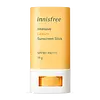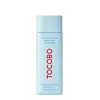What's inside
What's inside
 Key Ingredients
Key Ingredients

 Benefits
Benefits

 Concerns
Concerns

 Ingredients Side-by-side
Ingredients Side-by-side

Vinyl Dimethicone/Methicone Silsesquioxane Crosspolymer
Polyethylene
AbrasiveIsopropyl Palmitate
EmollientSilica
AbrasiveSynthetic Fluorphlogopite
Diethylamino Hydroxybenzoyl Hexyl Benzoate
UV FilterTocopheryl Acetate
AntioxidantOzokerite
Emulsion StabilisingBis-Ethylhexyloxyphenol Methoxyphenyl Triazine
Skin ConditioningDehydroacetic Acid
PreservativeTocopherol
AntioxidantWater
Skin ConditioningHamamelis Virginiana Leaf Extract
Skin ConditioningHouttuynia Cordata Extract
Skin ConditioningParfum
MaskingCurcuma Longa Root Extract
MaskingPropylheptyl Caprylate
EmollientBisabolol
MaskingPolyglyceryl-4 Diisostearate/Polyhydroxystearate/Sebacate
EmulsifyingCetyl Ethylhexanoate
EmollientEthylhexyl Palmitate
EmollientHelianthus Annuus Seed Oil
EmollientPropanediol
SolventCitric Acid
BufferingEthylhexyl Salicylate
UV AbsorberPolyurethane-11
Sodium Benzoate
MaskingEthylhexyl Methoxycinnamate
UV AbsorberButyloctyl Salicylate
Skin ConditioningLinalool
PerfumingLimonene
PerfumingVinyldimethicone
Triethoxycaprylylsilane
Benzotriazolyl Dodecyl P-Cresol
UV AbsorberEthylhexyl Triazone
UV AbsorberDicaprylyl Carbonate
EmollientPotassium Sorbate
PreservativeCentella Asiatica Extract
CleansingDistearyldimonium Chloride
Helianthus Annuus Seed Oil Unsaponifiables
EmollientButylphenyl Methylpropional
PerfumingPolysilicone-15
UV FilterEchium Plantagineum Seed Oil
Skin ConditioningSalvia Hispanica Seed Extract
EmollientSaccharide Hydrolysate
HumectantOctyldodecanol
EmollientBenzyl Salicylate
PerfumingDibutyl Adipate
EmollientDimethicone
EmollientCardiospermum Halicacabum Flower/Leaf/Vine Extract
Skin ConditioningHomosalate
Skin Conditioning1,2-Hexanediol
Skin ConditioningLauryl PEG-9 Polydimethylsiloxyethyl Dimethicone
Skin ConditioningPortulaca Oleracea Extract
Skin ConditioningVinyl Dimethicone/Methicone Silsesquioxane Crosspolymer, Polyethylene, Isopropyl Palmitate, Silica, Synthetic Fluorphlogopite, Diethylamino Hydroxybenzoyl Hexyl Benzoate, Tocopheryl Acetate, Ozokerite, Bis-Ethylhexyloxyphenol Methoxyphenyl Triazine, Dehydroacetic Acid, Tocopherol, Water, Hamamelis Virginiana Leaf Extract, Houttuynia Cordata Extract, Parfum, Curcuma Longa Root Extract, Propylheptyl Caprylate, Bisabolol, Polyglyceryl-4 Diisostearate/Polyhydroxystearate/Sebacate, Cetyl Ethylhexanoate, Ethylhexyl Palmitate, Helianthus Annuus Seed Oil, Propanediol, Citric Acid, Ethylhexyl Salicylate, Polyurethane-11, Sodium Benzoate, Ethylhexyl Methoxycinnamate, Butyloctyl Salicylate, Linalool, Limonene, Vinyldimethicone, Triethoxycaprylylsilane, Benzotriazolyl Dodecyl P-Cresol, Ethylhexyl Triazone, Dicaprylyl Carbonate, Potassium Sorbate, Centella Asiatica Extract, Distearyldimonium Chloride, Helianthus Annuus Seed Oil Unsaponifiables, Butylphenyl Methylpropional, Polysilicone-15, Echium Plantagineum Seed Oil, Salvia Hispanica Seed Extract, Saccharide Hydrolysate, Octyldodecanol, Benzyl Salicylate, Dibutyl Adipate, Dimethicone, Cardiospermum Halicacabum Flower/Leaf/Vine Extract, Homosalate, 1,2-Hexanediol, Lauryl PEG-9 Polydimethylsiloxyethyl Dimethicone, Portulaca Oleracea Extract
Water
Skin ConditioningDibutyl Adipate
EmollientPropanediol
SolventEthylhexyl Triazone
UV AbsorberTerephthalylidene Dicamphor Sulfonic Acid
UV AbsorberPolyglyceryl-3 Distearate
EmulsifyingNiacinamide
SmoothingTromethamine
BufferingCetearyl Alcohol
Emollient1,2-Hexanediol
Skin ConditioningDiethylamino Hydroxybenzoyl Hexyl Benzoate
UV FilterPentylene Glycol
Skin ConditioningPolysilicone-15
UV FilterVigna Radiata Seed Extract
Skin ConditioningGossypium Herbaceum Extract
Skin ConditioningSophora Flavescens Root Extract
AntioxidantRheum Palmatum Root/Stalk Extract
AstringentScutellaria Baicalensis Root Extract
AstringentPhellodendron Amurense Bark Extract
Skin ConditioningOenothera Biennis Flower Extract
AstringentUlmus Davidiana Root Extract
Skin ConditioningPinus Palustris Leaf Extract
TonicPueraria Lobata Root Extract
HumectantSodium Hyaluronate
HumectantGossypium Herbaceum Seed Oil
Skin ConditioningPolymethylsilsesquioxane
Sodium Polyacryloyldimethyl Taurate
Emulsion StabilisingGlyceryl Stearate
EmollientBis-Ethylhexyloxyphenol Methoxyphenyl Triazine
Skin ConditioningPotassium Cetyl Phosphate
EmulsifyingGlycerin
HumectantGlyceryl Stearate Citrate
EmollientInulin Lauryl Carbamate
Emulsion StabilisingAmmonium Acryloyldimethyltaurate/Vp Copolymer
Ethylhexylglycerin
Skin ConditioningAdenosine
Skin ConditioningButylene Glycol
HumectantTocopherol
AntioxidantParfum
MaskingWater, Dibutyl Adipate, Propanediol, Ethylhexyl Triazone, Terephthalylidene Dicamphor Sulfonic Acid, Polyglyceryl-3 Distearate, Niacinamide, Tromethamine, Cetearyl Alcohol, 1,2-Hexanediol, Diethylamino Hydroxybenzoyl Hexyl Benzoate, Pentylene Glycol, Polysilicone-15, Vigna Radiata Seed Extract, Gossypium Herbaceum Extract, Sophora Flavescens Root Extract, Rheum Palmatum Root/Stalk Extract, Scutellaria Baicalensis Root Extract, Phellodendron Amurense Bark Extract, Oenothera Biennis Flower Extract, Ulmus Davidiana Root Extract, Pinus Palustris Leaf Extract, Pueraria Lobata Root Extract, Sodium Hyaluronate, Gossypium Herbaceum Seed Oil, Polymethylsilsesquioxane, Sodium Polyacryloyldimethyl Taurate, Glyceryl Stearate, Bis-Ethylhexyloxyphenol Methoxyphenyl Triazine, Potassium Cetyl Phosphate, Glycerin, Glyceryl Stearate Citrate, Inulin Lauryl Carbamate, Ammonium Acryloyldimethyltaurate/Vp Copolymer, Ethylhexylglycerin, Adenosine, Butylene Glycol, Tocopherol, Parfum
 Reviews
Reviews

Ingredients Explained
These ingredients are found in both products.
Ingredients higher up in an ingredient list are typically present in a larger amount.
1,2-Hexanediol is a synthetic liquid and another multi-functional powerhouse.
It is a:
- Humectant, drawing moisture into the skin
- Emollient, helping to soften skin
- Solvent, dispersing and stabilizing formulas
- Preservative booster, enhancing the antimicrobial activity of other preservatives
You might know this ingredient as Tinosorb S or Bemotrizinol. It is a UV filter that covers both UVA and UVB rays.
This ingredient has two peak UV absorption peaks ( 310 and 340 nm) and is able to absorb both UV-A and UV-B rays. This ingredient works by preventing UV rays from reaching and damaging your skin.
On top of that - it is highly photostable and helps prevent the photodegration of other sunscreen ingredients such as avobenzone.
Tinosorb S is allowed in the EU, Australia, and Asia. It is close to being approved by the FDA and we'll hopefully get this ingredient in the U.S. by late 2025.
Fun fact: Tinosorb S is the most effective UV absorber at maximum concentration (measured by SPF) permitted in the EU.
This ingredient is oil-soluble, so your oil-cleansers will take this right off at night.
Learn more about Bis-Ethylhexyloxyphenol Methoxyphenyl TriazineDibutyl Adipate is an emollient and solvent. It is created from butyl alcohol and adipic acid.
As a solvent, Dibutyl Adipate helps mix and disperse ingredients evenly.
Dibutyl Adipate is soluble in water and organic solvents. It does not absorb UV rays.
Learn more about Dibutyl AdipateDiethylamino Hydroxybenzoyl Hexyl Benzoate (DHHB) is a chemical UV-A absorber. It is formulated for high UVA protection (320-400 nm).
DHHB is well-liked for:
DHHB has been approved by the EU, Japan, Taiwan, and South America for use up to 10%. Unfortunately, it has not been approved for use in the US or Canada due to slow regulatory processes.
This ingredient is soluble in oils, fats, and lipids.
Learn more about Diethylamino Hydroxybenzoyl Hexyl BenzoateEthylhexyl Triazone is a modern chemical sunscreen that protects from UV-B radiation.
It is the most effective of existing UV-B filters, as it provides the highest level of photo-stable absorption. It protects from the entire UV-B range (280 to 320nm), with it's highest level of protection at 314nm.
Ethylhexyl Triazone is oil soluble, oderless and colorless, which mean it is able to be incorporated into a variety of different formulations.
It is not currently available within the United States due to slow changing FDA regulations. Outside of the US, it is used in formulations at concentrations up to 5%.
Learn more about Ethylhexyl TriazoneParfum is a catch-all term for an ingredient or more that is used to give a scent to products.
Also called "fragrance", this ingredient can be a blend of hundreds of chemicals or plant oils. This means every product with "fragrance" or "parfum" in the ingredients list is a different mixture.
For instance, Habanolide is a proprietary trade name for a specific aroma chemical. When used as a fragrance ingredient in cosmetics, most aroma chemicals fall under the broad labeling category of “FRAGRANCE” or “PARFUM” according to EU and US regulations.
The term 'parfum' or 'fragrance' is not regulated in many countries. In many cases, it is up to the brand to define this term.
For instance, many brands choose to label themselves as "fragrance-free" because they are not using synthetic fragrances. However, their products may still contain ingredients such as essential oils that are considered a fragrance by INCI standards.
One example is Calendula flower extract. Calendula is an essential oil that still imparts a scent or 'fragrance'.
Depending on the blend, the ingredients in the mixture can cause allergies and sensitivities on the skin. Some ingredients that are known EU allergens include linalool and citronellol.
Parfum can also be used to mask or cover an unpleasant scent.
The bottom line is: not all fragrances/parfum/ingredients are created equally. If you are worried about fragrances, we recommend taking a closer look at an ingredient. And of course, we always recommend speaking with a professional.
Learn more about ParfumPolysilicone-15 is a chemical UV filter that absorbs UV-B rays.
It is a photostable ingredient used to boost SPF factor and protect products from UV-induced deterioration.
This ingredient is not water-soluble.
Learn more about Polysilicone-15Propanediol is an all-star ingredient. It softens, hydrates, and smooths the skin.
It’s often used to:
Propanediol is not likely to cause sensitivity and considered safe to use. It is derived from corn or petroleum with a clear color and no scent.
Learn more about PropanediolTocopherol (also known as Vitamin E) is a common antioxidant used to help protect the skin from free-radicals and strengthen the skin barrier. It's also fat soluble - this means our skin is great at absorbing it.
Vitamin E also helps keep your natural skin lipids healthy. Your lipid skin barrier naturally consists of lipids, ceramides, and fatty acids. Vitamin E offers extra protection for your skin’s lipid barrier, keeping your skin healthy and nourished.
Another benefit is a bit of UV protection. Vitamin E helps reduce the damage caused by UVB rays. (It should not replace your sunscreen). Combining it with Vitamin C can decrease sunburned cells and hyperpigmentation after UV exposure.
You might have noticed Vitamin E + C often paired together. This is because it is great at stabilizing Vitamin C. Using the two together helps increase the effectiveness of both ingredients.
There are often claims that Vitamin E can reduce/prevent scarring, but these claims haven't been confirmed by scientific research.
Learn more about TocopherolWater. It's the most common cosmetic ingredient of all. You'll usually see it at the top of ingredient lists, meaning that it makes up the largest part of the product.
So why is it so popular? Water most often acts as a solvent - this means that it helps dissolve other ingredients into the formulation.
You'll also recognize water as that liquid we all need to stay alive. If you see this, drink a glass of water. Stay hydrated!
Learn more about Water